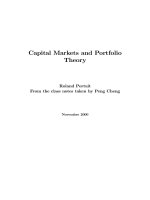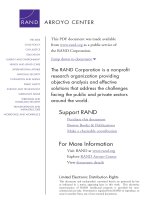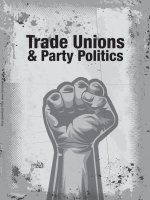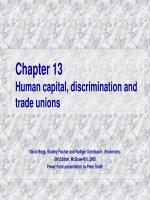human capital, discrimination and trade unions
Bạn đang xem bản rút gọn của tài liệu. Xem và tải ngay bản đầy đủ của tài liệu tại đây (167.6 KB, 21 trang )
Chapter 13
Human capital, discrimination and
trade unions
David Begg, Stanley Fischer and Rudiger Dornbusch, Economics,
6th Edition, McGraw-Hill, 2000
Power Point presentation by Peter Smith
13.1
Hourly earnings in the UK 1998
0
2
4
6
8
10
12
14
£.p
Manual Nonmanl
Men Women
In both manual and
non-manual
occupations, men
are seen to earn
more than women.
Does this mean
there is
discrimination?
13.2
Sources of differential pay
Education and training
Job experience
Race and gender
Trade union membership
13.3
Human capital
The stock of expertise accumulated
by a worker
It is valued for its income-earning
potential in the future
A form of investment
13.4
Age-earnings profiles
Age-earnings
profiles show how
typical earnings
vary with age and
educational
qualifications
– education induces
a differential
– which tends to
increase with age
Age
Income
No formal
qualifications
A-level or
equivalent
University degree
or equivalent
13.5
Worker organizations designed to
affect pay and working conditions
A closed shop
– an agreement that all the firm's workers
will be members of a trade union.
A trade union may raise wages by
restricting labour supply
Trade unions
13.6
Unions in the labour market
Employment
W
0
With no union, the industry
faces a horizontal labour
supply curve at the wage W
0
.
Given industry demand for
labour DD, equilibrium
is at E
0
.
D
D
E
0
N
0
By restricting labour
supply to N
1
, the union
can increase wage to W
1
N
1
W
1
The differential is larger for any
given reduction in industry
employment, the more inelastic
is industry labour demand
13.7
Discrimination?
Women and non-whites on average
receive lower incomes than white
males
women and non-whites are
concentrated in relatively unskilled
jobs with fewer opportunities for
promotion
This need not reflect blatant sexism
or racism by employers
13.8
Discrimination?
It may reflect:
– educational or other disadvantages
before young workers reach the labour
market
– a low perceived rate of return for firms
on money spent in training such
workers
Only if we allow for all these effects
can we show discrimination in the
labour market.
13.9
Chapter 14
Capital and land:
completing the analysis of factor markets
David Begg, Stanley Fischer and Rudiger Dornbusch, Economics,
6th Edition, McGraw-Hill, 2000
Power Point presentation by Peter Smith
14.11
Capital and land
Physical capital
– the stock of produced goods which
contributes to the production of goods
and services
Land
– the factor of production which nature
supplies
Together capital and land make up
the tangible wealth of a country.
14.12
Investment
Capital depreciates over time
– becoming less productive and less valuable
Gross investment
– the production of new capital goods and the
improvement of existing capital goods
Net investment
– gross investment minus the depreciation of
the existing capital stock
14.13
Stocks and flows
A stock
– the quantity of an asset at a point in
time
– the asset price is the sum for which the
stock can be bought outright
A flow
– the stream of services that an asset
provides during a period
– the rental rate is the cost of using
capital services
14.14
Interest and present value
The present value of £1 at some future date is the
sum that, if lent out today, would accumulate to
£1 by that future date.
– It depends upon how far into the future the sum
accumulates
– and on the rate of interest
The price of a capital asset should be related to
the stream of future payments that will be earned
from the services it provides
– discounted back to give the present value.
14.15
Real and nominal interest rates
The nominal interest rate
– tells us how many actual pounds will be
earned in interest by lending £1 for one year.
The real rate of interest
– measures the return on a loan as the increase
in goods that can be purchased rather than as
the increase in the nominal value of the loan
fund.
The real rate of interest is the nominal rate
minus the inflation rate.
14.16
The equilibrium real interest rate
Current consumption
Future consumption
A
A'
AA' shows the production
possibility frontier between
current and future
consumption:
by devoting resources to
investment, future
consumption can be
increased.
The slope of the frontier
has magnitude –(1 + i)
where i is the rate of
return on investment.
14.17
The equilibrium real interest rate
Current consumption
Future consumption
A
A'
U
U
Given society's preferences
between present and future
consumption, the optimal
position is at E, where the
indifference curve UU is at
a tangent to the PPF.
E
The slope of the red line
represents –(1 + r),
where r is the real interest
rate that balances the
productivity of investment
and the thriftiness of
consumers.
14.18
The markets for capital and land
The derived demand curve for capital
(and for land) services closely
parallels the earlier analysis of
labour demand.
But land is in fixed supply to the
economy as a whole.
Rental rates tend to become
equalized across alternative uses.
14.19
Changes in capital intensity
Over time, the UK economy is
becoming more capital-intensive
– the wage-rental ratio has increased,
leading industries to substitute capital
for labour
– in the long run the supply of labour is
less elastic than the supply of capital
– new capital embodies latest technology
14.20
The functional distribution of income in the UK
0%
20%
40%
60%
80%
100%
1981-89 1998
Employment Self-employment Profits & rents
The distribution of income between the factors of
production changed little between 1981-89 and 1998.









